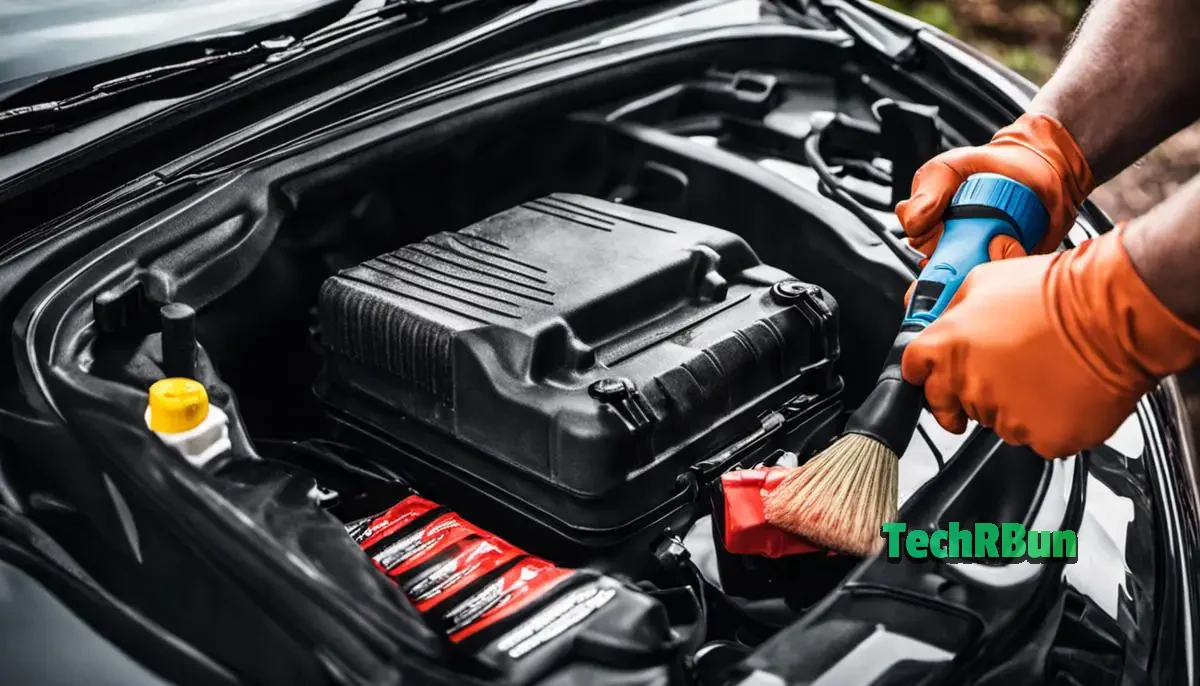If you’ve ever found yourself stranded, unable to start your car due to a dead battery after it was parked for some time, you know how frustrating this predicament can be.
Fortunately, this is a preventable problem. This discussion revolves around the common causes of battery drain in parked cars, how to test for parasitic drain – an often overlooked factor – and practical measures you can take to maintain your car battery’s health and prolong its life.
The objective is to provide you with the knowledge and tools necessary to prevent unnecessary battery death, ensuring you get where you need to go, without any car battery-related hitches.
Table of Contents
Identifying Common Causes for Battery Drain
Car enthusiasts out there, gear up for an electrifying knowledge ride! Our subject today is a common quandary that leaves many automobile buffs scratching their heads: the mystery of a car battery draining while parked. It’s a perplexing issue, right?
Thankfully, troubleshooting doesn’t have to feel like solving an intricate puzzle. Let’s arm ourselves with knowledge and break down the most common causes behind this enigma.
1. Parasitic Drains
Don’t be spooked by the name. We’re not entering the realm of the supernatural; rather, we’re tackling a serious cause of battery drainage.
Parasitic drains occur when devices continue to utilize power even after the engine is shut off. This could be due to a malfunctioning light left on or a grocery-bag induced accidental trunk light switch fail.
Solution: Regularly check interior and exterior lights before exiting your car.
A thorough guide, to check and prevent parasitic battery drain in your car, is provided below.
2. Alternator Issues
A weak or failing alternator can be a silent villain in the battery drain saga. How so, you wonder? Well, the alternator functions as a generator, recharging the battery while the car is in motion.
If this nifty device is malfunctioning, it may not charge the battery sufficiently leading to inevitable draining over time.
Solution: Have your alternator checked periodically for optimal functioning.
3. Old Battery
Remember that batteries aren’t immortal. Over time, they lose their capacity to hold a charge. Generally, car batteries last between 3-5 years, thereby making age a significant factor.
An old or weak battery can often succumb to cold temperatures, proving that weather isn’t always a car’s best friend.
Solution: Regularly test your battery’s strength, especially if it’s over three years old.
4. Extreme Cold
Cars like to stay cozy too, and extremely cold temperatures could cause the battery to drain faster. The cold weather can make the battery’s chemical reactions sluggish, meaning it struggles to hold a charge.
Solution: If possible, park your car in a garage or at least a sheltered space during extreme winter conditions.
5. Hidden Electrical Issues
Like little gremlins, hidden electrical problems can cause significant mishap where it’s least expected.
This could be any lingering electrical issue, a wiring problem, or even a faulty radio. Keep an eye, ear, and nose out for telltale signs of trouble like burning smells, blown fuses, or spontaneously triggered alarms.
Solution: Head to a professional mechanic for a comprehensive electrical diagnostic test.
6. Lack of Regular Use
Cars aren’t built to sit idle. The irony of a mobile machine is that when unused for significant periods, the battery could naturally discharge and drain.
Remember to take the car out regularly for a ‘health run’. It’s a nice excuse for a jaunt too.
Solution: Run the car for at least 30 minutes every week.
So, now we’ve navigated through the common causes of battery drainage while parked. By staying ahead of these, we can spare ourselves from exasperating battery woes.
It’s all about retaining impeccable tuning with your automobile and understanding it beyond the hum of the engine.

Testing And Solving Parasitic Battery Drain While Car Is Idle Or Parked
An individual with a burning passion and immense knowledge about car maintenance knows all too well that parasitic drain can silently and steadily deplete their car battery.
Identifying and measuring this invisible adversary helps circumvent inconvenient breakdowns and facilitates timely maintenance.
Thus, let’s dive into the process of detecting and measuring a parasitic drain on your car battery!
Step 1: Acquiring the Necessary Tools
To unmask this invisible power thief, a multimeter becomes your trusted companion.
This versatile electrical instrument is available at most hardware stores and online. It measures voltage, current, and resistance, making it a useful tool in your car maintenance arsenal.
Additionally, a pair of work gloves and protective goggles ensure safe operation, guarding against accidental sparks.
So, these are the things you need:
- A Multimeter
- A pair of work gloves
- Protective goggles
Step 2: Preparing Your Car
Safety first! Start by ensuring your car is off and entirely stationary.
Disconnecting any charging devices and turning your vehicle’s lights and other electrical systems off is crucial.
Removing the key from the ignition gets you ready to hunt for the elusive parasitic drain.
Step 3: Connecting the Multimeter
Now comes the real challenge.
Align your multimeter to measure current (amperage) as this will directly reveal the presence and magnitude of the parasitic drain.
Connect the multimeter in series with your battery—specifically, the multimeter’s negative lead should connect to the battery’s ground cable (usually black), while the positive lead attaches to the battery’s negative terminal.
Step 4: Reading the Results
Keep in mind that cars with modern electronic systems and alarms may exhibit a small amount of parasitic drain (about 50 milliamps) under normal circumstances.
Therefore, a reading higher than 50mA typically confirms the presence of a significant parasitic drain.
Step 5: Isolating the Causes
If your multimeter reveals a higher-than-normal reading, the detective work doesn’t stop here—it shifts gears!
Isolate the issue by pulling out each fuse one by one and observing changes to the multimeter reading.
When unplugging a particular fuse leads to a drop in the reading, you potentially found the troublemaker: the circuit associated with that fuse.
Step 6: Professional Intervention
If your knowledge and comfort level permits, you could further troubleshoot within the problematic circuit, isolate faulty components, and replace them.
However, if the circuits are perplexing, professional automotive electricians are well-equipped to deal with intricate wiring systems. They can accurately identify and address the problematic area, ensuring your vehicle operates at its peak performance.
You’ve now not only gained the know-how to identify this common cause of battery drain but also have a practical roadmap to combat it!
The path to maintaining a well-performing car battery most times lies in understanding, detecting, and quantifying parasitic drain effectively.
So, gear up, prepare your multimeter, and seize control of the unseen power thief eating away at your car battery’s life.

Car Battery Maintenance Practices
Building on this insightful foundation, we will drill down into the finer points that will help keep your car battery vibrant and reliable regardless of where the journey takes you.
One of the first things to remember is the importance of ‘completing the cycle.’ A car battery is not dissimilar to your beloved home appliances. They crave regular use!
Neglecting to complete the charging cycle, which happens when you start your car, can jeopardize the battery’s long-term health.
This is because your battery needs to reach a full charge to avoid the risk of sulfation—a process that can reduce the battery’s ability to hold a charge over time.
On the subject of charging, one often overlooked battery maintenance practice involves the use of a battery maintainer.
This tool keeps your battery charged at the optimum level, especially during periods of little to no use—an ideal solution for that summer convertible during the frosty winter months.
It slowly adds charge to the battery and folds its operation once a full charge is attained, mitigating overcharging hazards.
Next, let’s focus on cleanliness—an obvious yet understated factor. A clean battery is a happy battery. Accumulated dirt and grime can create a pathway for power to leak across the top of the battery, leading to an unnecessary drain.
So pick up that cleaning solution (baking soda and water work too) and give your battery and its connections a regular scrub down.
While you’re cleaning, take note of the battery’s electrolyte level. For batteries with removable caps, it’s essential to maintain this level to ensure a functional battery.
Use distilled water to top it off. And be careful to avoid overfilling—it’s a Goldilocks situation, where the level has to be just right.
Lastly, don’t forget about the battery’s environment. Its comfort matters! An insulated battery is protected against temperature extremes, ensuring consistent performance. For those residing in colder climates, a thermal blanket could be a wise investment.
In essence, meticulous care for your battery revolves around regularity, cleanliness, and care with tools that augment its longevity.
You wouldn’t ignore thirst or fatigue in your body, so don’t overlook the signs of a thirsty or tired battery. By being proactive, you ensure that your car battery will be there for you, full of energy, for every ignition and every journey.

Knowing what drains your car battery when parked and how to maintain it is fundamental in ensuring its longevity and reliability.
From understanding the role of internal lights, the alternator, and the impact of parasitic drain to mastering how to charge your battery correctly and when to disconnect it, you’re now equipped with insightful tips to ensure you’re never caught off guard by a dead battery again.
Remember, prevention is always better than cure, and with these proactive practices, your car battery can serve you efficiently for years to come.






